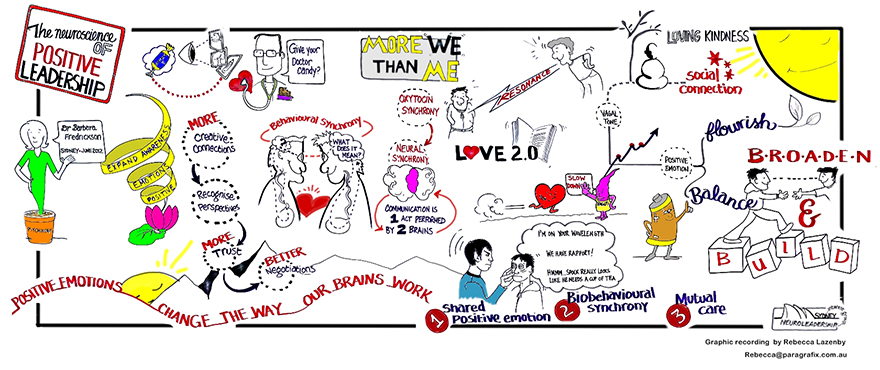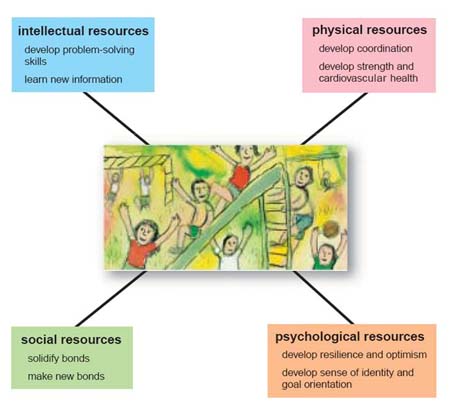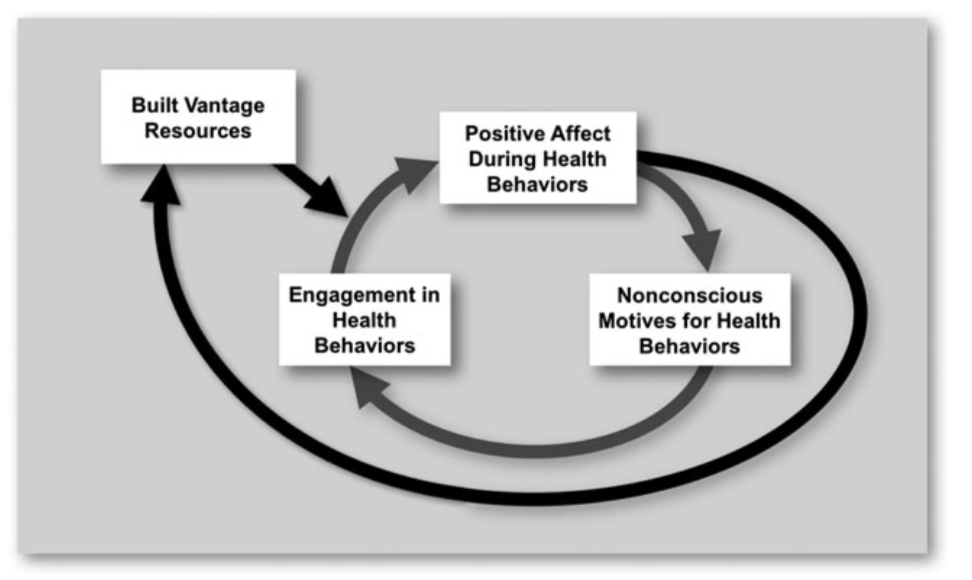
PEP Lab Theories
The Broaden-and Build Theory of Positive Emotions
Why do humans have positive emotions? This is the central puzzle that Professor Fredrickson worked on early in her career. Previously, theoretical accounts of the evolution of human emotions neglected positive emotions aside from their contribution to mate selection and reproduction. In 1998, Professor Fredrickson articulated their role in survival with her Broaden-and-Build Theory of Positive Emotions. The theory posits that humans’ present-day experiences of positive emotions were shaped over millennia by the forces of natural selection because pleasant emotional states created momentary and embodied states of expanded awareness that, over time, aggregated to augment an individual’s resources for survival, including social alliances, resilience to adversity, knowledge and reasoning capacity, and physical fitness and health. The Broaden-and-Build Theory helped launch the scientific study of positive emotions and constitutes a foundational theory for positive psychology. It also serves as the base for two more recent offshoot theories, the Positivity Resonance Theory of Co-experienced Positive Affect and the Upward Spiral Theory of Lifestyle Change.

For more information, check out these articles and publications:
- Fredrickson (2001) American Psychologist
- Fredrickson (1998) Review of General Psychology
- Fredrickson (2013) Advances in Experimental Social Psychology
The Positivity Resonance Theory of Co-experienced Positive Affect
Professor Fredrickson integrates theory and evidence from affective science, relationship science, and developmental science into a novel and generative framework to advance the scientific study of the emotion of love. The Positivity Resonance Theory of Co-experienced Positive Affect holds that concepts commonly related to “love” (e.g., desire, intimacy, trust, commitments) are best understood as the products of the accumulation of momentary experiences of love, the emotion, defined as positivity resonance. Moments of positivity resonance emerge in circumstances in which real-time sensory connection (e.g., face-to-face interaction) is combined with perceived safety and are inferred from the presence of three key indicators: shared positive affect (an experiential component distributed across individuals), caring nonverbal synchrony (a behavioral component marked by nonverbal movements and gestures associated with care and love that are linked in form and tempo across individuals), and biological synchrony (a physiological component marked by shifts in affect-related biomarkers linked in form and tempo across individuals). When moments of positivity resonance recur between and among individuals this accumulation functions to build and fortify enduring social bonds (love, the relationship) and later become steady resources for individuals through good times and bad (“in sickness and in health”).

For more information, check out these articles and publications:
The Upward Spiral Theory of Lifestyle Change
Professor Fredrickson has also investigated how positive affective processes can be leveraged to support people’s long-term maintenance of desired positive health behaviors. Past evidence has shown that health behaviors experienced as pleasant are more likely to be maintained. The Upward Spiral Theory of Lifestyle Change unpacks this relation with emphasis on automatic, often nonconscious motives and malleable vantage resources that render people more sensitive to subsequent positive experiences. The behavioral neuroscience of addiction reveals that over time, associations between pleasantness (“liking”) and cues predictive of it endow those cues with incentive salience, making them more likely to subsequently capture attention and trigger urges to repeat that experience (“wanting”). To the extent that positive affect is experienced during a new health behavior, the Upward Spiral Theory posits that it creates nonconscious motives for that activity, which grow stronger over time as they are increasingly supported by vantage resources, both biological and psychological, that positive affect serves to build. The figure below depicts the recursive dynamic processes articulated by the theory.

For more information, check out these articles and publications:
- Van Cappellen, Rice, Catalino, & Fredrickson (2017) Psychological Health
- Van Cappellen, Catalino, & Fredrickson (2020) Emotion
Current Research
Social and Neural Integration (SANI) Study
Following 22 years of research on the Broaden and Build Theory, the SANI study is the first examination of the neural mechanisms by which positive emotions broaden awareness and lead to prosocial actions and virtues, such as intellectual humility and generosity. Using cutting-edge network neuroscience theory, we examine how neural integration during positive and negative emotion states predict a range of individual and social well-being outcomes. This project is in collaboration with Drs. Kristen Lindquist and Jessica Cohen, and is currently beginning data collection. Funding for this study comes from a Mind & Life Institute PEACE Grant.
Technology and Positive Behavioral Goals Study
Human relationships with machines are evolving. Computers are increasingly partners rather than tools, agents rather than simple objects. Artificially intelligent agents now serve as assistants, wellness coaches, and even companions. This raises important questions about the kinds of AI agents we ought to build and how to deploy them. We hypothesize that, if built and used in the right ways, AI agents can help improve people to be better versions of themselves. We are currently conducting the “Technology and Positive Behavioral Goals” study, in which we are examining the psychological, social, and behavioral effects of interactions with an AI agent programmed to encourage individuals to adopt positive health behaviors. Funding for this study comes from the Templeton World Charity Foundation. (Click here, if you are a UNC undergraduate and are interested in participating!)
Additional Individual and Lab Projects
Goods in Everyday Love: this line of work examines community benefits of positivity resonance. Specifically, the findings suggest that daily recurring moments of positivity resonance travel in sync with prosocial tendencies such as altruism, humility and spirituality (Zhou et al., in press), which further predicts public health behaviors such as social distancing and mask wearing during COVID 19 (West et al., 2020) as well as people’s intentions to be vaccinated against COVID-19 and willingness to sign up for a vaccine trial (Berman et al., in prep).
Economic Inequality, Social Class and Positivity Resonance: Led by Taylor West, this line of work investigates how social class and perceptions of economic inequality influence social connection with people around the community, and downstream consequences for both individual health and community prosociality.

